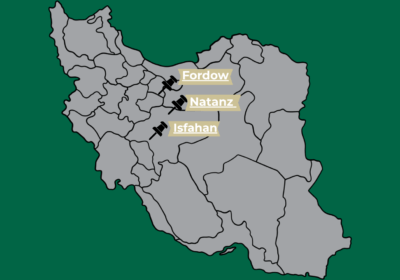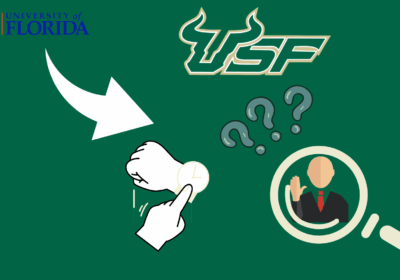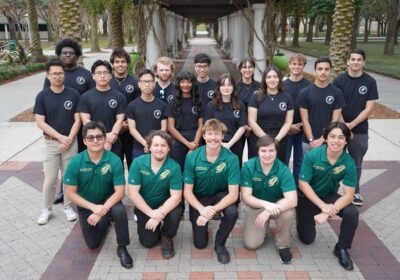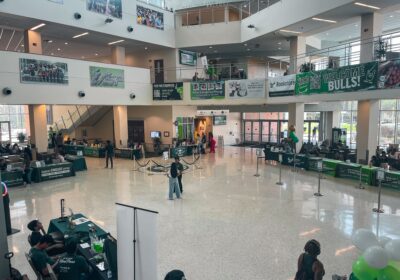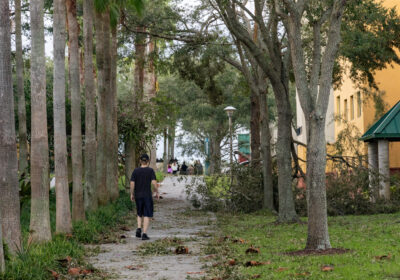Researchers rescue missing boater

Researchers from the Florida Institute of Oceanography housed at USF assisted the U.S. Coast Guard to save a man from the Gulf of Mexico on Saturday night. PHOTO PROVIDED BY MARK COLLINS
The crew and some of the students aboard a Florida Institute of Oceanography (FIO) research vessel likely had no idea they would help save a man’s life on the last day of their research cruise.
Around 9 p.m. on Saturday night, the U.S. Coast Guard issued an urgency broadcast signal indicating there were three boaters separated from their boat in the Gulf of Mexico between Egmont and Passage Keys, which is one to two miles from the closest coastline.
While the Coast Guard was able to quickly rescue two of the three boaters, the third remained separated from the others and adrift in the dark waters of the Gulf.
Realizing the man was nearby, the captain of FIO’s R/V Weatherbird II, Brendon ‘Boomer’ Baumeister, determined where the boater was likely located, and he, the crew and some of the students on the ship searched for about an hour before finally spotting the missing boater and taking him aboard.
FIO Director William Hogarth said he was happy the crew and students were able to perform the rescue, and he said this was a good opportunity for the students present to learn about the risks of working at sea.
“It’s a tough environment, and we stress safety here,” Hogarth said. “I’m proud they were able to get involved and were in the right place at the right time.”
The six graduate students onboard, two of whom are USF students, were scheduled for a four-day research cruise from June 18 to 21 accompanied by their professors — chemical oceanographers Kristen Buck from USF St. Petersburg, Angela Knapp from FSU and Dreux Chappell from Old Dominion University.
Baumeister said the students were ahead of schedule on their way back Saturday evening, so he dropped speed to avoid returning too early and brought the R/V Weatherbird II closer to Tampa Bay at 8 p.m. to get cell phone coverage for the students and crew.
This slight change in plans may have been the reason they were able to rescue the missing boater, as about an hour later, Baumeister said he heard the Coast Guard’s urgency broadcast and plotted the given location to find they were only two miles away.
“We decided to respond… and called the Coast Guard to let them know we were in the area and would assist with the search,” he said. “At this point (the Coast Guard) had a small boat searching, and I believe a helicopter was on its way.”
Baumeister, who has been with FIO for five years and involved with more than 100 research cruises in his career, said it is not uncommon for him to hear urgency broadcasts about people separated from their boats. He said it is very rare, however, to be in a position to assist with the search.
“I have responded to Coast Guard calls before, but I’ve never run an active search and then rescued a person,” Baumeister said.
By the time they reached the location indicated by the Coast Guard, the missing boater had been in the water for about half an hour. To increase their chances of finding him alive, Baumeister needed to make a set and drift calculation to determine where the man had likely drifted to.
Baumeister said quickly finding the missing boater was imperative because he didn’t have a life jacket or locating device and every minute is critical when treading water in the Gulf. Baumeister recalled a prior instance in Asia during his previous employment as a ship captain when local responders unfortunately arrived too late.
“The last person I pulled out of the water was dead,” he said. “People on board said they thought they saw a mannequin … and I turned around and it was a body. … When you’re alone in the water with no life jacket at night, the odds are definitely against you.”
Al Savor, the R/V Weatherbird II’s engineer, said finding the missing boater was especially difficult due to the cover of night and the flocks of birds. Despite Savor and Baumeister using the ship’s large spotlights to scan the water, there were several false alarms during the search.
“This guy we found didn’t have a life vest, a light or a whistle, so he was basically 10 inches of head above the water,” Savor said.
After searching for about an hour, Savor said they decided to turn off all non-essential equipment which made noise, such as their exhaust fans, in an attempt to hear the boater calling for help. Baumeister had also instructed the students who came up to the bridge after noticing the commotion to act as lookouts to make sure they didn’t hit the boater during their search.
After five or 10 minutes of searching with minimal noise, Savor said they heard the man shouting and were finally able to locate him with the ship’s spotlights. He said Baumeister then told the students to not take their eyes off the boater, as there was a chance they could lose sight of him in the water.
As Baumeister maneuvered the ship around to pick up the boater, Savor said he threw the man a life ring, strobe and rope before pulling him on deck.
The crew then performed a brief assessment of the boater’s health and determined he was mostly unharmed other than being tired, dehydrated and bleeding from an incision from hernia surgery two days prior. The man told the researchers he would have only survived for a few more minutes, and they brought him water before a small Coast Guard boat arrived with the other two missing boaters.
Baumeister said he and the present Coast Guardsmen then allowed the boaters to come aboard the R/V Weatherbird II where the boaters reunited and gave their thanks to the researchers before being taken back to shore.
“It was lots of tears and lots of hugging, and then the hugging turned to us,” Baumeister said. “It was a great ending to a potentially very sad night.”


